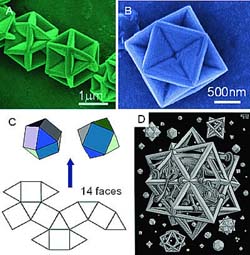Aug 11 2006
An artistic-flavored breakthrough in the field of crystal studies made by YU Shuhong from the Hefei National Laboratory for Physical Sciences at Microscale (HFNL), the University of Science and Technology of China (USTC), and his colleagues has recently been published by Chemistry of Materials and highlighted by the August 3 issue of Nature under the title of "Crystal growth: Star Quality."

"Recipe for making geometric 'stars': dissolve copper nitrate in ethylene glycol, add sulphur and bake well. The result, report Shu-Hong Yu of the University of Science and Technology of China in Hefei and his co-workers, is microscopic crystals of copper sulphide that have a beautiful cuboctahedral form, reminiscent of the cages drawn by M. C. Escher in his 1948 engraving Stars. They are composed of four intersecting hexagonal plates and contain 14 concave cavities," Nature indicates.
Before that, in American Chemical Engineering and News published on July 24, a detailed report and comment had already been given on the new outcome in an article entitled "Escher goes chemical," which is quoted as saying:
"In his 1948 wood engraving Stars, Escher celebrated geometric symmetry in a composition of polyhedrons, including a cuboctahedron, in which an octahedron infiltrates a cube. Now chemists from Hefei National Laboratory for Physical Sciences at Microscale, in China, and the Max Planck Institute of Colloids & Interfaces, Germany, have made micrometer-scale cuboctahedral structures.
"Each copper sulfide cuboctahedron consists of four intersecting hexagonal flakes, each about 2 mm across, yielding cuboctahedra with eight tetragonal and six pyramidal cavities.
"To make the Escherian crystals, the researchers prepared an ethylene glycol solution of Cu(NO3)2 and elemental sulfur, which they autoclaved at 140°C for a day. After they collected the resulting black solid by centrifugation, scanning electron microscope imagery gave Shu-Hong Yu and his coworkers a most welcome surprise.
"It is appealing that a synthetic technique as simple as the one presented here can produce such beautiful objects that even a skilled craftsman cannot touch on the microscale level," the researchers noted.
They also suggested "building blocks for larger structures and encapsulating agents for other materials are among the structures' potential uses."
Yu"s research group has been focusing on the studies of multilayer structures of bio-mineralization materials for an effective control over the construction, measurement and performance of special nanostructured materials, and explorations have been made in designing specially-structured and multifunctioned materials under natural circumstances. Their research has been supported by CAS Outstanding Overseas Scholars Recruitment Program, National Outstanding Young Scientists Funds and CAS-MPG partner group in USTC.
Escher was a Dutch graphic artist well-known for his prints and engravings using realistic details to achieve bizarre optical illusions. His works were of interest to mathematicians, cognitive psychologists and the general public, and were widely reproduced especially in the 1960s and 1970s.
http://english.cas.ac.cn